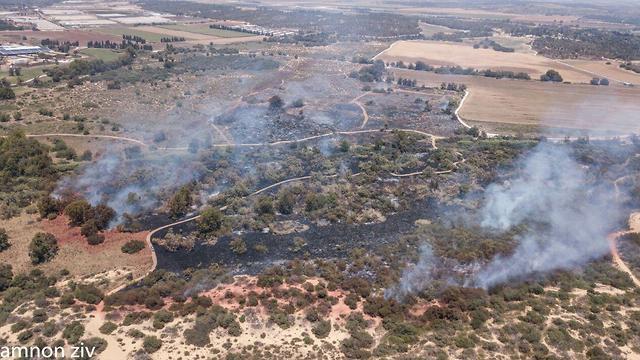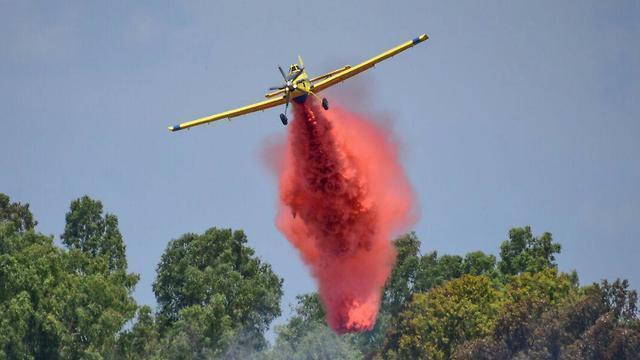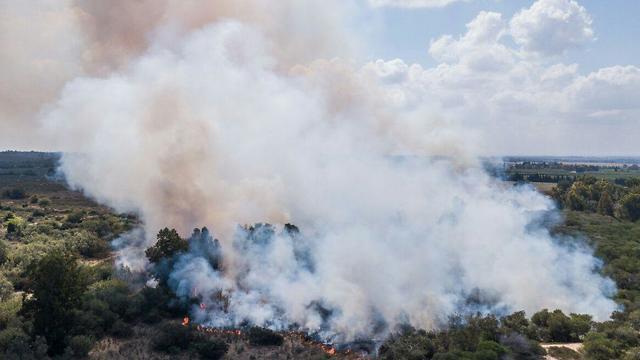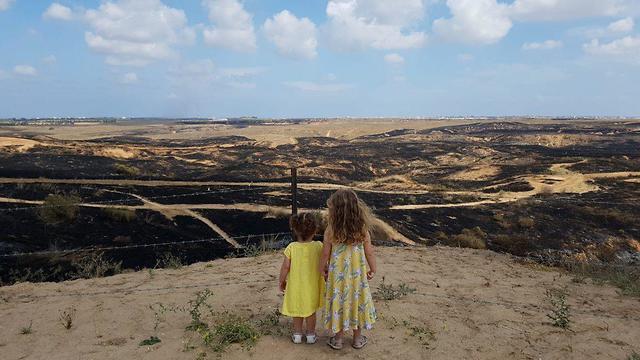Getting your Trinity Audio player ready...
The Incendiary kites from Gaza are consuming not only the agricultural produce and wheat fields of the Israeli communities surrounding Gaza, but also the area's animal population, groves and nature reserves.
The Israel Nature and Parks Authority (INPA) is concerned about the animal population dwindling in the areas that where set on fire by the incendiary kites flown from Gaza. The area's birds managed to escape the blaze, whereas some of the reptiles did not.
Fires across Karmiya Reserve amid incendiary kites flown from Gaza
(צילום: רועי עידן, נוגה בנודיז)
Severe damage was caused Saturday to Hof Ashkelon Regional Council's Karmiya Reserve as a result of an incendiary kite sent from Gaza. INPA said it received a report at 8 am about a fire spreading across the Karmiya Reserve—one of the Negev's beautiful reserves.
The kite caused a fire that consumed 300 dunams (about 75 acres) out of the reserve's some dunams acres and it is difficult to estimate how long it will take the reserve to be rehabilitated.
The reserve's reptile population did not stand a chance. Nevertheless, the INPA estimates the hyenas and swamp cats survived the fires.
According to Coby Soffer, Israel's southern coastal plain's inspector, Karmiya Reserve overlaps with Shikma Reservoir where (the fires) began. "When I arrived at the scene the firefighting forces had already been working (to put out the blaze).
"At first firefighting planes were not allowed to participate in putting out the fires since the site's vicinity to the (Gaza) border, and only later they began assisting the firefighting forces," Soffer explained.
"The fire was relatively in low intensity, but set fire to trees. The firefighting forces operated impressively and out of consideration of the reserve," The inspector added.
4 View gallery


Fires across Karmiya Reserve amid incendiary kites flown from Gaza
(צילום: אמנון זיו)
"Swamp cats, Cranes, hyenas and their cubs populate the reserve during this time of year. I assume the hyenas will know how to lead their cubs out of areas inflicted by the fire, albeit not always. Most of the damage done is to the reptile population and ground-incubating animals such as partridges and their chicks. There are birds that are still nesting," he elaborated.
"Our tortoises obviously don't have a chance to escape the fire, as well as the snakes that didn't take cover. I assume that animals deep inside holes in the ground are protected," Soffer went on to say.
Eurasian hobbies also nest in the Karmiya Reserve, however it is not yet clear whether they were affected by the fire.
The reserve contains various plants that are defined "red," such as the Tel-Aviv Garlic. The fire's effect on those plants, if any, is not yet known.
A large amount of quills covered the reserve's territory, and according to Soffer "Many visitors are seen touring the reserve area in September and a white carpet (of plants) cover the area. All the short bushes were harmed."
The desert monitors—which is a species of the longest grey lizard in Israel—had been spotted in the past in the reserve and cameras were placed to locate them. The grey lizard can be usually found in the Negev and Ha'arava.
The Israel Nature and Parks Authority is holding a count of the species in the southern coastal plain, from Palmachim to Netiv HaAsara. It is still not clear how long it will take to rehabilitate the reserve that had Ficus sycomorus and Carob trees among others. Some trees have been damaged beyond rehabilitation.
Soffer said that in the middle of May he holds a count of mammals and some of their routes pass through the reserve's area. "If somebody lights up a match and throws it in this area, it would be difficult to turn off the fire. We are talking about a bushy area that house many animals who feel protected here."
"The reserve is covered with animals' footsteps passing through its routes. People don't pass through those routes. I went to Shikma Reservoir and felt pain seeing how the fire destroyed it," he lamented.
Karmiya Reserve's terrain, as well as the strong winds, made it very difficult for the firefighting teams to subdue to blaze and four firefighting planes were called to assist them. Thick smoke covered the area and there was a concern the fire would spread to moshav Netiv HaAsara's greenhouses.
This is the first time a fire breaks out in this area as a result of an incendiary kite flown from Gaza.
In addition, two additional fires broke out on Saturday amid incendiary kites launched from Gaza.
One fire had broken out in the Kissufim Forest and was subdued by firefighting forces and Eshkol Regional Council's security forces.
A short while after that another fire broke out in a field adjacent to Kibbutz Nir Am and spread very close to the Kibbutz's fence.
Firefighting teams succeeded to prevent it from spreading into the Kibbutz just in the nick of time.
The INPA knows it will take a long time to rehabilitate the extensive damage made to the nature reserve.
Damage to HaBsor Stream area due terror kite
(צילום: בעז פריפלד, רשות הטבע והגנים)
According to the authority, a large portion of the area's flora was destroyed and most of them will not recover until next year's rain. The animals' habitat has become smaller and the rate of fires is daily.
INPA also said the last fire in HaBesor Stream consumed 3,000 acres of nature reserve—which means the terrain in the area will also not recover until the next rain season and the animals' pasture area is diminishing.
"This year the rules of the game are completely different. It's still hard to say what will be the effect (of the fires) on nature. If this continues into the summer, we'll be in a bad situation," the Israel Nature and Parks Authority warned.







